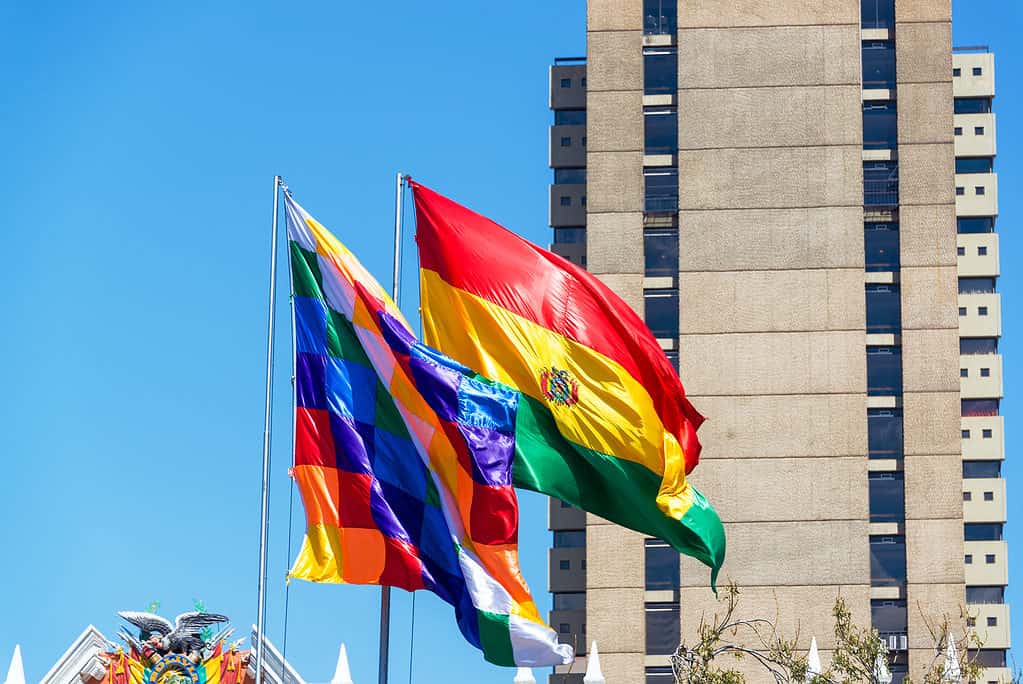The official flag of Bolivia is the national flag of the Plurinational State of Bolivia. The Plurinational State of Bolivia is actually a landlocked nation in west-central South America. Brazil’s northern and eastern borders, Paraguay’s southeast, Argentina’s south, Chile’s southwest, and Peru’s west all border this country. The first official flag of Bolivia, or the formal state flag, was initially adopted in 1851.
Since 2009, the wiphala, a flag representing the indigenous people of Bolivia, has also served as the nation’s second flag, or “dual flag.” According to Bolivia’s 2009-updated constitution, the wiphala is one of the nation’s symbols, along with the flag, national anthem, and coat of arms. Interested in learning more? In this article, we will explore in detail the flags of Bolivia, including their history, meaning, and symbolism.
Flag of Bolivia History

©Jess Kraft/Shutterstock.com
The 1800s
Bolivia’s coat of arms was placed in the center of its horizontal yellow-red-green-green flag, which was first flown on July 25, 1826. Manuel Isidoro Belzu, the president at the time, officially adopted the modern Bolivian flag on October 31, 1851. However, its coat of arms has been altered several times since then, including the addition of a tenth star.
2004
In 2004, during the presidency of Carlos Mesa, it was decided that the National Shield, or Bolivian coat of arms, would be on the flag flown during political activities. It would not be required to be present on the civil flag. This is the version flown throughout civic, patriotic, and public events.
2009
The flag under Evo Morales’ administration received several symbolic alterations as a result of Supreme Decree No. 241, which was issued on August 5, 2009. President Evo Morales, who was the nation’s first indigenous leader, designated the wiphala, a checkered flag with a rainbow of colors, as the second official flag of Bolivia in 2009. Additionally, the wiphala has been included in the flag of the Bolivian Navy.
At the time, there was a lot of disagreement within the larger Bolivian community. Some of the people of Bolivia disagree with the second flag because the wiphala is a flag that only represents the Andean peoples, the Quechua, and the Aymara. However, Bolivia recently became the “Plurinational State of Bolivia” to ensure that all of its citizens feel equally represented. As a result, imposing the Andean culture on everyone else goes against what the new Bolivian Constitution represents.
Since the adoption of the revised 2009 constitution, in addition to the tricolor flag, the wiphala has also been officially flown on governmental structures, including the parliament and the Palacio Quemado. It must be hoisted parallel to Bolivia’s official flag wherever it is flown. On official occasions, both should be raised to the right.
Flag of Bolivia Meaning

©Tatohra/Shutterstock.com
Design
Bolivia’s national flag is a tricolor rectangle with the colors red, yellow, and green in equal proportions. It consists of three horizontal bands: red on the superior portion, yellow on the middle band, and green on the inferior part. These horizontal stripes have the Bolivian coat of arms in the center of the government ensign. Over the years, as it has been modified, a tenth star has been added to the coat of arms.
The size of the national flag was eventually determined in 2004. Its present dimensions are 7.5 squares wide by 11 squares long, with every square having a ratio of 15:22.
Colors
The national flag of Bolivia is made up of the colors red, yellow, and green. The dual flag of Bolivia (the Wiphala flag) is made up of the following colors: red, orange, yellow, white, green, blue, and violet.
Flag of Bolivia Symbolism
The first description of Bolivia’s national flag and its significance was made by the Supreme Decree of 1888, which was signed by President Gregorio Pacheco. It officially reads as follows:
Red: “represents the blood shed by our heroes for the birth and preservation of the Republic”
Yellow: “represents our wealth and resources.”
Green: “represents the richness of our natural areas as well as hope, a foundational value of our society”
The colors have also long been associated with a variety of ideas, including the power of the army (red), the availability of natural resources (yellow), and the soil’s fertility (green).
The nine previous stars of the coat of arms represent Bolivia’s departments; the tenth star represents the country’s valuable territory.
The Wiphala

©Gil C/Shutterstock.com
The rainbow’s seven visible hues are represented by 49 squares in the wiphala. The national colors of the Bolivian Air Force now incorporate the wiphala. Red denotes the planet Earth and the Andean man; orange, society and culture; yellow, energy; white, time; green, resources; blue, the heavens; and violet: Andean self-government and independence.
Some contend that the Wiphala Bolivian flag fosters national division rather than unity. They believe that by exclusively representing Bolivia’s indigenous population, the wiphala encourages marginalization in a country that has long suffered from racial and cultural injustice. The wiphala is still present, but through time, people have become accustomed to it and have come to respect it for the history and tradition that it is meant to represent.
Up Next:
- White, Green, and Red Flag: Bulgaria Flag History, Meaning, and Symbolism
- Black, Red, and Yellow Flag: Germany Flag History, Symbolism, Meaning
- Green, White, and Blue Flag: Sierra Leone Flag History, Meaning, and Symbolism
The post The Flag of Bolivia: History, Meaning, and Symbolism appeared first on AZ Animals.
from Animal News, Facts, Rankings, and More! - AZ Animals https://ift.tt/WnO0sdN